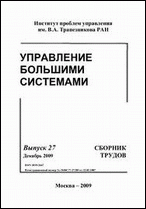|
Control in Social and Economic Systems
Making a typology of scientists on the basis of bibliometric data
I. Vasilyeva, P. Yu. Chebotarevb
a Moscow Institute of Physics and Technology (State University), Dolgoprudny, Moscow region
b Institute of Control Sciences of RAS, Moscow
Abstract:
In this paper, we propose a set of indicators for solving the problem of differentiation and stratification of scientists on the basis of bibliometric data using cluster analysis. The indicators include three standard citation indexes and five structural indexes characterizing the citation curve of a researcher. The latter indicators are defined in terms of increments of the annual citation rate, which characterize the time convexity of the total number of references. Ward's hierarchical clustering algorithm is applied to some sets of mathematicians, physicists, and psychologists with high citation rates. The analysis of the obtained results allows one not only to describe several stable types of scientists, but also to study the differences between distinct groups of scientists in various scientific disciplines. For mathematicians and physicists, three groups, “youth”, “luminaries”, and “inertial”, can be clearly distinguished, regardless of the way of clustering. The proportions of the corresponding groups are relatively stable and similar. In addition, among the mathematicians, a group “precocious” manifests itself, while among physicists, we observe a group of scholars who “caught the wave”. For psychologists, the clusters are essentially different. In many cases, the cluster structures revealed with and without standard citation indexes turn out to be similar.
Keywords:
typology of scientists, scientometrics, bibliometrics, citation indices, cluster analysis, Google Scholar.
Received: May 29, 2017
Published: March 31, 2018
Citation:
I. Vasilyev, P. Yu. Chebotarev, “Making a typology of scientists on the basis of bibliometric data”, UBS, 72 (2018), 138–195
Linking options:
https://www.mathnet.ru/eng/ubs948 https://www.mathnet.ru/eng/ubs/v72/p138
|

| Statistics & downloads: |
| Abstract page: | 1487 | | Full-text PDF : | 422 | | References: | 61 |
|




 Contact us:
Contact us: Terms of Use
Terms of Use
 Registration to the website
Registration to the website Logotypes
Logotypes








 Citation in format
Citation in format 